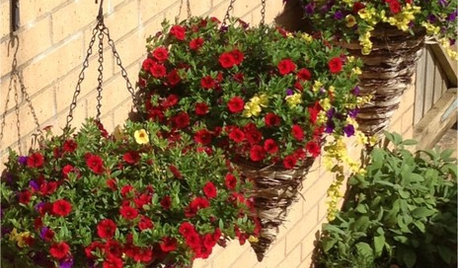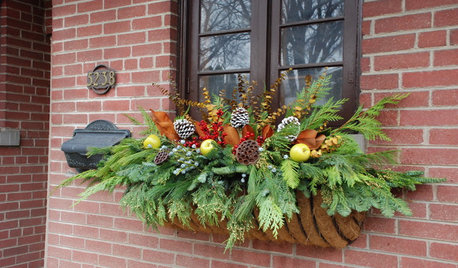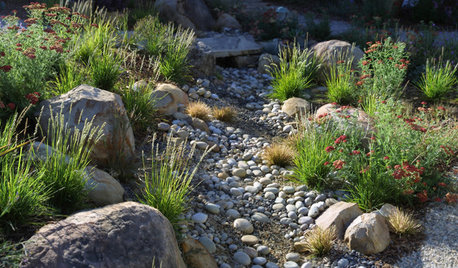Container Soils - Water Movement & Retention VII
tapla (mid-Michigan, USDA z5b-6a)
15 years ago
Featured Answer
Sort by:Oldest
Comments (150)
libbyc
15 years agolast modified: 9 years agotapla (mid-Michigan, USDA z5b-6a)
15 years agolast modified: 9 years agoRelated Discussions
Container Soils - Water Movement & Retention XV
Comments (155)Hi, rina. I know wood chips are different than bark, but I saw a nursery that was using these mixed with some alder saw dust. In about a year it turned to this incredible black, rich "soil". The guy as the nursery said it breaks down better and more nutritious for the soil and depletes less nitrogen in the process. The wood chips I was seeking are about the size of medium bark in nurseries. In retrospect, I am glad I didn't try that. Works great outdoors, not sure about containers! The black bark is essentially composted evergreen tree bark. I say evergreen because it could be a mix of a number of different types here in the Pacific NW --- hemlock, fir, ceder, spruce, etc. I didn't screen it, it seemed plenty loose initially; small to medium size in comparison to bagged nursery store bark. It would have been o.k. had I added the peat and perlite per the formulas given here. Screening would have left just the larger pieces, but that would be quite a chore for the volume I was using! I repotted some of the plants using the 5:1:1 formula with my black bark and those are doing much, much, better. A gardening friend said "Think of it...bark is like big saw dust. If you pack it down it gets as hard as a board". That is essentially what happened when I used the black bark alone without the the perlite and moss. ;(...See MoreContainer Soils - Water Movement and Retention XI
Comments (150)Hi Al, With all the ingredients in hand, I've started the sifting process and had a few questions. I'm trying to swap out 50 containers worth of soil so I'd prefer to do this in the most efficient way. I am using a 9x9 hardware cloth (.088" openings) to filter the fines. Here are the three ingredients I was able to source: 1) Shasta: Orchid Fir Bark: (1/8" - 1/4") http://shastabark.com/products.htm 2) Turface MVP 3) 1/8" Crushed Granite (Desert Gold) http://www.lyngsogarden.com/index.cfm?event=Display.Home.Product.Group&homeCategory=STONE&categoryid=1094&productgroup=PEBCOB&groupname=Pebbles%252C%2520Cobbles%2520%2526%2520%2520Colored%2520Gravel Questions: 1) It seems like it takes a decent amount of time to screen out the fines for one container. I also have constructed two other screens to be used to filter out the larger particles (a 1/4" for the large fir bark and a 9x9 (.1387") for the larger turface/granite). I'm assuming that at the end of the day it is more important to screen out the fines then to screen out the few larger pieces which may be in the mix. Would this be correct? I'm just trying to save some time and there doesn't seem to be that many larger pieces in the mixes. 2) Do you usually rinse out the mixes before you combine them? Does this help get additional dust/fines out? 3) What do you do with all the fines/dust that you sift out? If you are screening out larger pieces what do you with them? Thanks so much in advance. Your advice and guidance have been invaluable. Best, Kernul1...See MoreContainer Soils - Water Movement and Retention XVII
Comments (202)Exactly, the paper i pasted from describes the same phenom you have been describing for over 10 years. I have always raged that the big greenhouse media suppliers claim that 30% perlite into a peat is a high porosity mix. And so many growers prefer short squatty containers [helpful for blow over prevention but nothing else] Container Geometry is almost as important as the mix. i remember in 1984 I took a 400 level greenhouse management course at University of Delaware. The prof soaked a rectangular sponge and held it by the edges parrallel to the sink flatwise and let water drain, then he rotated the sponge on the shorter vertical axis and more water drained, when that free drainage ended he then rotated the sponge vertically in it tallest plane and more water drained. When I read your suggestion about using a draping shoelace as draining wick to lower the PWT the distance of the wick, I shouted YES at the elegant simple brilliance. In 1977 I grew a marijuana plant in a milk crate full of gravel, the stalk was over 2 inches in diameter [no different than growing in glass.] BTW, in your gritty mix what are the ratios and actual particle size for each component? I would think to use slightly larger particle sizes than i think you were using and i would probably consider using zeolite or a calcined DE or calcined clay. BTW, Ep minerals makes several absorbents both DE and Clay, Calcined or regular as various spill absorbers available in any auto parts store. 5o pounds for about 10 dollars. Don''t know the particle sizes but likely need to be screened to eliminate the fines. The clays are generally calcium bentonite and not sodium bentonite so less sodium and less swelling. I beileve Arcillite and Tuface are calcium bentonites. I was just thinking that decomoposed granite and even bark add no water holding capacity but with DE and Proper sized ceramics you could add more waterholding capacity but still maintain the airspace. The airspace in the ep mineral clay was pretty low when I measured it last, but I did not screen it. Somewhere I have a spreadsheet with AFP, WHC, TP, TPv, etc for over a dozen components and mixes. I have run quite a few in both 16 oz and taller 32 oz cups, [1 liter exactly when filled to rim overflow which makes that size intuitively easy for all the math. I think i found your posts about 3 years ago and then lost them. Am I correct in thinking you have some water release curve data around somewhere. Someone posted some WRC showing that Axis DE or perhaps the Axis clay media held huge amounts of water but easily released over 75% to the plant. TI can not find that post. I was actually searching for Vertical hydraulic conductivity, Capillary Rise and Capillary rate and wicking when your links showed up. The axis DE is like $90 a bag for 50 pounds so i think I could more cheaply reproduce from other products but have to screen. where I live in idaho, there is a Celatom DE plant less than 60 miles away, 2 zeolite mines, a sodium bentonite mine, WHC and Airspace mid 20s in the 2 larger particle sizess. Also the best white pumice [Hess] source mine a few hours away. I had hoped better water holding capacity. I plan on rerunning all the mixes again in a few months now that i have more standardized my process using multiple cup sizes, some of them tamped or shaken to settle, some top watered, some bottom water, measure distance of subsidence if any. I also have a vegetronix tensionometer now and will take additional measures at various depths to measure the exact tension and also verify depth of pWT which i can usually see through the transparent cups if I use a marking dye and saturate from below. Anyway I will share those spreadsheets in the near future If i were to guess, you have some sort of plant and soil science background or some civil engineering background and a love for plants. At any rate, your explanations and examples are some of the best I have ever come across, and your shoelace suggestion is brilliant, truly. i read so much WRONG advice or the wrong analysis for reason why something works or does not work. it is refreshing to come across accurate information Garret Goyette...See MoreContainer Soils - Water Movement & Retention XIV
Comments (164)Thanks for the kind words, B&C. In Mississippi, Memorial day would be a good target date for repotting the fig. Hibiscus need an annual repot. Do that toward the end of March, before it starts growing in earnest. Apple and most deciduous trees should be repotted just before or at the onset of spring budswell. Cactus - ask the cactus experts at the cacti/succulents forum. Desert rose - in Mississippi - June Umbrella plant - June There are ways to mechanically limit the amount of perched water a planting will hold, even if you're using a very water-retentive medium. Eliminating all or most of the perched water allows the grower to use media that would otherwise be or border on the edge of unusable. This outlines ways to cope with heavy (water-retentive) media Another effective way of dealing with media that hold too much water is through the use of ballast. You can read more about that technique here: Ballast ..... For now, checking your planting's moisture level regularly with a 'tell' will make a difference in your plant's appearance and level of vitality. Here's something I wrote about that: Over-watering saps vitality and is one of the most common plant assassins, so learning to avoid it is worth the small effort. Plants make and store their own energy source – photosynthate - (sugar/glucose). Functioning roots need energy to drive their metabolic processes, and in order to get it, they use oxygen to burn (oxidize) their food. From this, we can see that terrestrial plants need air (oxygen) in the soil to drive root function. Many off-the-shelf soils hold too much water and not enough air to support good root health, which is a prerequisite to a healthy plant. Watering in small sips leads to a build-up of dissolved solids (salts) in the soil, which limits a plant's ability to absorb water – so watering in sips simply moves us to the other horn of a dilemma. It creates another problem that requires resolution. Better, would be to simply adopt a soil that drains well enough to allow watering to beyond the saturation point, so we're flushing the soil of accumulating dissolved solids whenever we water; this, w/o the plant being forced to pay a tax in the form of reduced vitality, due to prolong periods of soil saturation. Sometimes, though, that's not a course we can immediately steer, which makes controlling how often we water a very important factor. In many cases, we can judge whether or not a planting needs watering by hefting the pot. This is especially true if the pot is made from light material, like plastic, but doesn't work (as) well when the pot is made from heavier material, like clay, or when the size/weight of the pot precludes grabbing it with one hand to judge its weight and gauge the need for water. Fingers stuck an inch or two into the soil work ok for shallow pots, but not for deep pots. Deep pots might have 3 or more inches of soil that feels totally dry, while the lower several inches of the soil is 100% saturated. Obviously, the lack of oxygen in the root zone situation can wreak havoc with root health and cause the loss of a very notable measure of your plant's potential. Inexpensive watering meters don't even measure moisture levels, they measure electrical conductivity. Clean the tip and insert it into a cup of distilled water and witness the fact it reads 'DRY'. One of the most reliable methods of checking a planting's need for water is using a 'tell'. You can use a bamboo skewer in a pinch, but a wooden dowel rod of about 5/16” (75-85mm) would work better. They usually come 48” (120cm) long and can usually be cut in half and serve as a pair. Sharpen all 4 ends in a pencil sharpener and slightly blunt the tip so it's about the diameter of the head on a straight pin. Push the wooden tell deep into the soil. Don't worry, it won't harm the root system. If the plant is quite root-bound, you might need to try several places until you find one where you can push it all the way to the pot's bottom. Leave it a few seconds, then withdraw it and inspect the tip for moisture. For most plantings, withhold water until the tell comes out dry or nearly so. If you see signs of wilting, adjust the interval between waterings so drought stress isn't a recurring issue. Al...See Morefilix
15 years agolast modified: 9 years agotapla (mid-Michigan, USDA z5b-6a)
15 years agolast modified: 9 years agofilix
15 years agolast modified: 9 years agodeep_roots
15 years agolast modified: 9 years agokimcoco
15 years agolast modified: 9 years agofilix
15 years agolast modified: 9 years agotapla (mid-Michigan, USDA z5b-6a)
15 years agolast modified: 9 years agoAariel
15 years agolast modified: 9 years agolinchat
15 years agolast modified: 9 years agotapla (mid-Michigan, USDA z5b-6a)
15 years agolast modified: 9 years agokimcoco
15 years agolast modified: 9 years agotapla (mid-Michigan, USDA z5b-6a)
15 years agolast modified: 9 years agokwyet1
15 years agolast modified: 9 years agotapla (mid-Michigan, USDA z5b-6a)
15 years agolast modified: 9 years agojustaguy2
15 years agolast modified: 9 years agofilix
15 years agolast modified: 9 years agotapla (mid-Michigan, USDA z5b-6a)
15 years agolast modified: 9 years agokwyet1
15 years agolast modified: 9 years agojustaguy2
15 years agolast modified: 9 years agoesteban_2009
15 years agolast modified: 9 years agotapla (mid-Michigan, USDA z5b-6a)
15 years agolast modified: 9 years agoterrace.newbie
15 years agolast modified: 9 years agolinchat
14 years agolast modified: 9 years agojustaguy2
14 years agolast modified: 9 years agolinchat
14 years agolast modified: 9 years agolinchat
14 years agolast modified: 9 years agoesteban_2009
14 years agolast modified: 9 years agotapla (mid-Michigan, USDA z5b-6a)
14 years agolast modified: 9 years agolinchat
14 years agolast modified: 9 years agotapla (mid-Michigan, USDA z5b-6a)
14 years agolast modified: 9 years agolibbyc
14 years agolast modified: 9 years agoragtimegal
14 years agolast modified: 9 years agoragtimegal
14 years agolast modified: 9 years agobuzzsaw8
14 years agolast modified: 9 years agopenfold2
14 years agolast modified: 9 years agoesteban_2009
14 years agolast modified: 9 years agoaliceinvirginia
14 years agolast modified: 9 years agotapla (mid-Michigan, USDA z5b-6a)
14 years agolast modified: 9 years agorj_hythloday
14 years agolast modified: 9 years agotapla (mid-Michigan, USDA z5b-6a)
14 years agolast modified: 9 years agoditnc
14 years agolast modified: 9 years agopat_123
14 years agolast modified: 9 years agotapla (mid-Michigan, USDA z5b-6a)
14 years agolast modified: 9 years agoditnc
14 years agolast modified: 9 years agorj_hythloday
14 years agolast modified: 9 years agotapla (mid-Michigan, USDA z5b-6a)
14 years agolast modified: 9 years agotapla (mid-Michigan, USDA z5b-6a)
14 years agolast modified: 9 years ago
Related Stories

CONTAINER GARDENSContainer Gardening Basics: The Dirt on Soil
Learn the types of potting soil available and the best mixes to help your containers thrive
Full Story
GARDENING GUIDES10 Solutions for Soggy Soil
If a too-wet garden is raining on your parade, try these water-loving plants and other ideas for handling all of that H2O
Full Story
GARDENING GUIDESHow to Stop Worrying and Start Loving Clay Soil
Clay has many more benefits than you might imagine
Full Story
GARDENING GUIDESHow to Pick a Mulch — and Why Your Soil Wants It
There's more to topdressing than shredded wood. Learn about mulch types, costs and design considerations here
Full Story
GARDENING GUIDESGreat Design Plant: Anemone Canadensis Adds Pizzazz to Water’s Edges
Plant Canadian anemone along pond, lake or stream edges for a splash of white flowers in late spring
Full Story
CURB APPEALCrazy for Colorful Cones: 5 Container Plantings Beyond the Bowl
Give even a small garden an exuberant vibe with hanging cones overflowing with blooming beauties
Full Story
FARM YOUR YARDHow to Grow Vegetables in Containers
Get glorious vegetables and fruits on your patio with a pro’s guidance — including his personal recipe for potting mix
Full Story
GARDENING GUIDES10 Dazzling Winter Container Designs
Get inspired by these ideas for festive arrangements in outdoor pots and planters
Full Story
GARDENING GUIDESHow to Install a Drip Irrigation System
Save time and water with a drip watering system in your vegetable garden — a little patience now will pay off later
Full Story
LANDSCAPE DESIGNHow to Design Your Landscape to Slow Down Water
Putting the brakes on stormwater runoff is the first step in sustainable water design
Full Story





et14